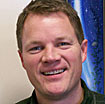In 1998, I was asked by Lake Wapogasset Lutheran Bible Camp in Amery, Wisconsin, to paint a mural backdrop for their Annual Christmas Dinner Theater.
Their staff had stretched a 13’x13′ sheet of muslin cloth over a wood frame on which I was to paint. It felt like a thin T-shirt and I had my doubts. As I applied a first layer of latex house paint with a roller brush, the muslin began to stretch tight and upon drying formed a canvas. My idea of using mural art in worship was born.
In the spring of 2006, our Worship and Music team and I took a risk and planned something different for Good Friday. I suggested painting a larger-than-life sized mural which would depict the events of the day. The team built the worship around the mural. The process of painting would take place throughout the worship service and be complimented with congregational participation, choral music, Scripture readings, narration, and silence. The word got out and within a year we were using overflow seating. This event has now become a significant part of our congregation’s tradition and a means of non-threatening evangelism.
Young or old, people can relate to a visual. Just as a sermon as it is being told can inspire an image in the mind of the hearer, so can a mural as it is being painted inspire and engage the observer in the Biblical story. Thus, my purpose in using mural art is to:
- actively engage viewers in the Biblical story
- connect God’s story to their lives, to proclaim the Gospel,
- create faith
As a congregation watches a mural being created, curiosity becomes a question and conversation: “I wonder what that will be,” or “Dad, that looks like a ____. What do you think?” Suddenly the comments change: “Ah, that’s what it is!” or “Look Grandma, I was right!” or “That was powerful.” Faith-talk across the generations happens. Young children are engaged. The Seasons of the Church Year are taught. A memorable, lasting impact is the result. Faith is inspired.
Most of the people in our congregations are “right-brain theological thinkers” (random, intuitive, holistic, subjective) as opposed to “left-brain theological thinkers” (logical, sequential, rational, analytical, objective). In other words, the majority of worshipers are not thinking of the Biblical story on an academic, theological level but rather on a subjective, visual level. People love to hear the parables of Jesus because Jesus “paints” a word picture. The audience can relate. They can “see” it in their mind’s eye. People are drawn to a visual image as it is being created. Worshipers become active participants in the story. They become a part of God’s story. Their creative, imaginative capacities are engaged. Youth, in particular, are visual in their thinking and understanding. Visual arts in the Church can inspire wonder, awe, curiosity, remembrance, and questions which pertain to faith and life. Without considering the thought-process context of our worshipers, we may both be missing opportunities for proclamation, and perhaps dismissing the God-given artistic gifts of those among us.
A developing mural can become a “shared language” across otherwise difficult-to-traverse boundaries. The viewer becomes the involved interpreter regardless of denomination, education, or culture. Ecumenical worship can happen perhaps at a deeper level. People of differing backgrounds can join together to see and hear the story unfold without being told how they are to theologically interpret the details.
A Biblical artist begins with the Word of God, a blank canvas, some paint, a few brushes, and an idea or two. Artistic creation begins with imaginative thinking. The creation that unfolds is not primarily the mural itself, but more importantly the faith in its observers as the Word of God touches lives. The image becomes clearer with time. The story comes into focus. At some level, watching a mural develop may be like Christ coming into the world. In time the image of God comes more clearly into focus with each brush stroke until finally, “the Word becomes flesh”. The worshiper can hear and see the Word “come to life.” I intentionally paint somewhat impressionistically so that there is “room for the Holy Spirit to work”.
My murals are painted on muslin cloth stretched across a frame built of 2′ x 4′ lumber. Images of various sizes are painted with latex house paint, a roller, and large brushes. Our Worship and Music team now plans our Good Friday Worship Service well in advance. The choir sings a thoughtfully selected Cantata, interspersed with congregational responses, Scripture readings, solos, instrumentals, silence, minor drama, and narration from the point of view of a witness of the crucifixion event. The lights are low. Angry crowd noise has been used. The mood is set. The Word comes to life artistically, musically, Biblically, narratively, and dramatically. Dressed in a black robe, I paint continuously throughout worship (sometimes on a rotating canvas). After completion, the murals are hung or stretched for display and are available for other churches to use.
To watch a video of the 2008 Good Friday Worship in action and see other murals, go to: http://www.paulomanwatercolors.com/muralart-new.asp
May God inspire you to seek out the God-given artistic gifts within your community for the proclamation of the Gospel of Jesus Christ.


